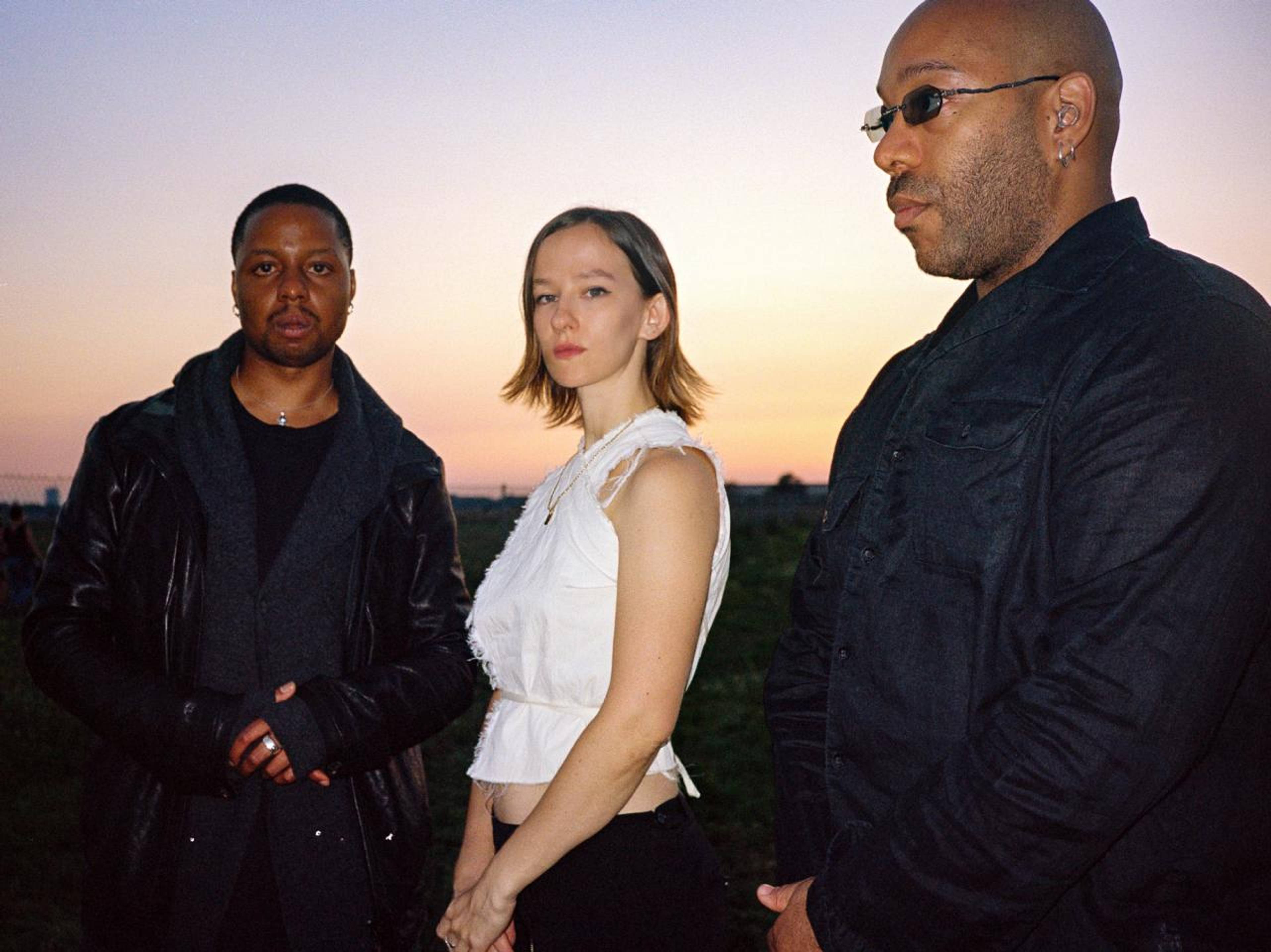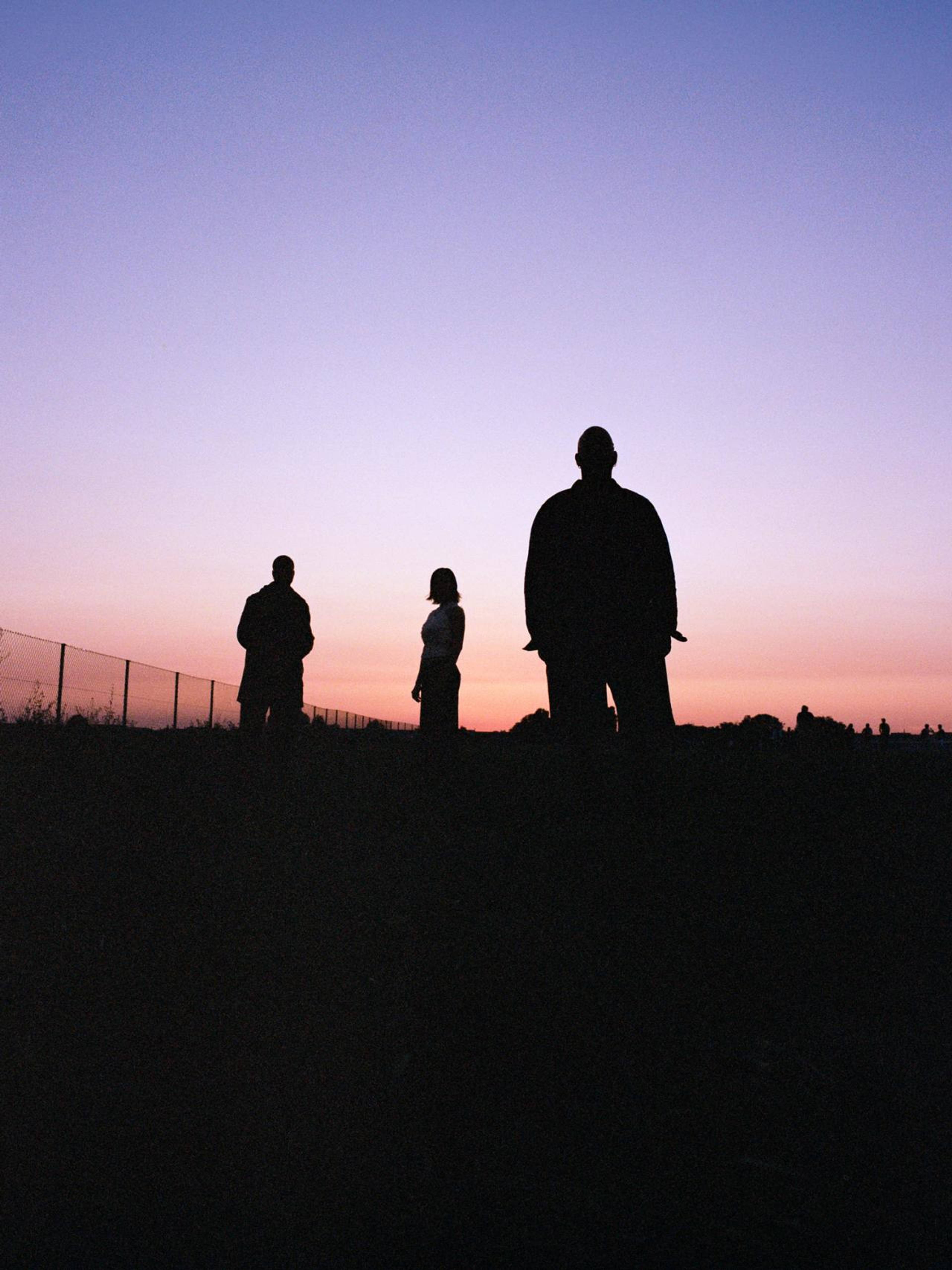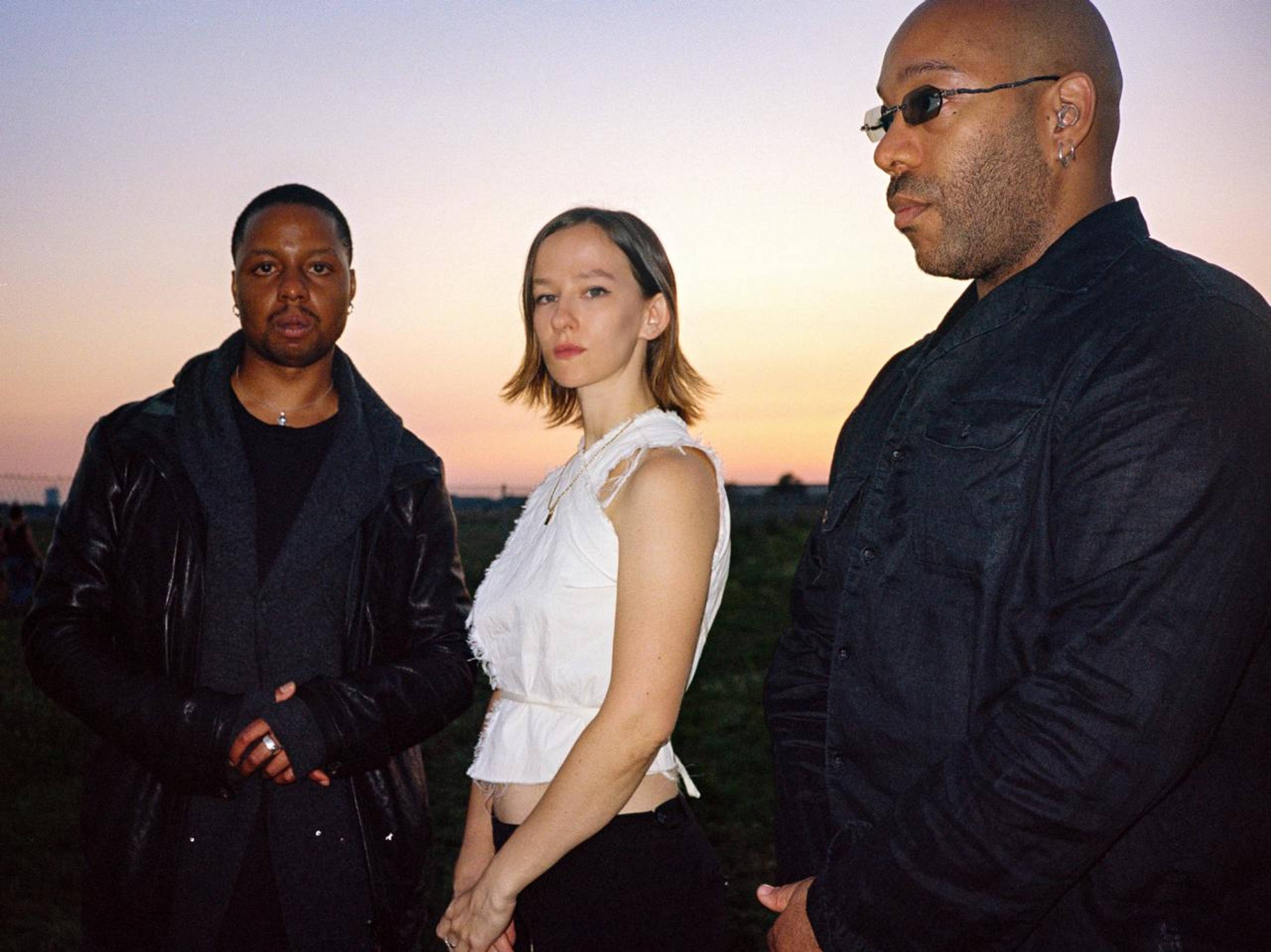Among the ambient washes, transgressive-ish techno, and cathedralizing hauntology of Berlin Atonal, an annual experimental electronic festival main-staged in the city’s other former-power-plant club, an inaugural collaborative set between loop-decay composer Caterina Barbieri and urbanscape dub duo Space Afrika was pointedly sparse and rich with silences, the baroque guitar, sampled electronics, and guest poetry coming together in a Last of England, proto-punk archipelago. Offstage and feeling over the moon about their organic trust, the musicians reflect on non-places as the future’s relics, pushing the limits of serenity, and the intuitive physicality of sound.
Steven Warwick: I’ll start off by asking the obvious question: How did this collaboration come around?
Joshua Reid: We met earlier this year, after Zíur played at Volksbühne here in Berlin. We were at 8MM Bar, having a proper catch-up for the first time, and just started swapping ideas back and forth.
Joshua Inyang: Yea, then you reached out to us, Cat.
Caterina Barbieri: Yes exactly. We met years ago at a festival we both played, but we didn’t meet up again in person. Then I was in touch with Atonal about doing something special, and I thought it would be a really nice collaboration, even though we are from very different backgrounds and our approaches to form are different. I feel our music connects on a similar emotional spectrum, like the kind of emotions we want music to channel, and the unpredictable combination worked very nicely.
SW: Space Afrika, you obviously play as a duo and have collaborated with artists like the rapper and choreographer Blackhaine. Caterina, do you often collaborate with other people? And what are your notions of the social in playing together generally?
CB: I’ve collaborated in the past with people like Kali Malone, Ellen Arkbro, and Bendik Giske, but these people come from my same music scene; Kali and Ellen were my classmates at the classical conservatory.
SW: When I saw you play together live, I was pleasantly surprised that it was more “song-based,” because listening to both of your music, I thought it would be more droney or long-form. How did that come about?
JI: One of the beautiful things about the collaboration is that we just dove into it without any anticipation or restriction on its form or how it should come out. There was just an extremely efficient use of the resources and sounds that we all shared, and we seemed to instantly bond on what we were building together, you know, sharing the folder, stems, writing new bits, responding to what each other had written. That process arrived somewhere in the middle of this long-form piece that very clearly had individual moments for the set. When we played at Atonal, it was actually the first experience of really practicing the music and putting it together – it was this show-and-tell for us, too. There were moments when the songs broke down into a more band-like presentation, which was a nice change from what myself and Josh and Cat are used to doing when we perform.
JR: Part of the process was really figuring out how they all could be defining last tracks. So, it actually felt quite natural to present them in a way that gave each individual piece space and clarity to shine, but also be played out in long-play format.
CB: The development process was very organic. As Josh said, we started sharing material very spontaneously: I was recording a little thing on the guitar and sending it to them, and they would take one part, record a little, send it back. The whole show and the tracks are short, but some of the sounds are recurring and the sonic palettes are very similar, because it’s music we did in a very condensed period of time. It feels to me like a journey.
© Leonardo Scotti 2023
SW: At Kraftwerk, there’s obviously a lot of natural reverb, and it’s very normal to see people playing with these dense, ambient washes of sound that the audience can walk around and “immerse” themselves in. But your set was more delicate, and even the silences between tracks heightened the human feeling inside that cavernous space. Did you feel a danger of this domineering industrial space enveloping your performance?
JI: Maybe I’m speaking for myself, but when I saw the industrial setting with Cat and Josh. the natural thought was to design a set that was more sensitive and serene than harsh, to play against the vastness and expectation. Having something so delicate was maybe less familiar to a space like that, but it was beautiful to push the serenity to its maximum, and anyway, I do think there was a very good balance with the noisier sound. We had a really lovely soundcheck where we could sharpen stuff for the space and consider the movement of the sounds around the room, so it wasn’t as intimidating as it may have appeared, and I think we just discovered in the moment that it was a very beautiful and appropriate way for things to unfold.
I felt, especially in collaboration with Cat, that having an extra member onstage with whom we already felt this complete trust was quite comforting actually, and right before the show, it was the first time where I really felt like going onstage and switching into a newly different mode, with the understanding that I had less control over the performance, but a greater responsibility, ultimately. Maybe the elevation and the vastness help blank out the sea of people in front of you, and it felt quite liberating and exciting to be up there.
a lot of people at kraftwerk work with drone or very dark, abrasive stuff. But it’s interesting to play with silence – what’s always inspired me is hearing the decay of sounds there, hearing the space’s presence.
SW: Caterina has mentioned elsewhere the organic and natural elements in her music, while Space Afrika has said theirs is really rooted in the city and urban spaces. How do those touchpoints work together?
JR: One of the benefits of playing at Kraftwerk is that we’ve all played there before, and this was a chance for us to recontextualize it. I think this was a perfect meeting in the middle, actually, which brought in elements from both sides in terms of sound and also stage presentation. We were able to bring some layering, field recording, and re-worked material, whereas Cat added instrumentation, synth, and voice.
Maybe that kind of presentation is not expected in that space, but the question then is why not? I think both themes are explored in everyone’s music in some capacity, with the challenge being to transcend your own practice.
CB: Even though industrial settings are not so apparent in my music, they’re the ones I enjoy the most, because I play a lot with reverb and isolated melodic gestures. The first time I played in Kraftwerk, which is my favorite venue, I was interested in bringing intimacy into the space. A lot of people, I think because of a visual association and the big brutalist architecture, work a lot there with drone or very dark, abrasive stuff. But for me, it was interesting to play with silence, because what’s always been very inspiring for me is hearing the decay of sounds there, hearing the space’s presence. The guitar also creates an intimacy, which is rare there.
© Leonardo Scotti 2023
SW: A lot of acts at Atonal brought religious themes or semiotics into their performances, heightening the sense of the Kraftwerk architecture as a church or even its offspring, the shopping mall: The church is covered in gold to mesmerize and seduce, with aural equivalents in chanting and reverb. Similarly, I saw Space Afrika perform at Volksbühne with a video of the mall at Manchester Arndale, an image that has stuck with me, maybe because of the IRA bombing there in 1996. Why do people respond this way to these spaces?
JR: It does feel like a church, in the sense of a “mass” and a pulpit. I think these industrial buildings are also spaces of congregations. People worked within these spaces in industrial labor, which is tied to politics through class movements and struggles, so there is something synonymous about them.
In postmodernity, urban landmarks like the Arndale building in Manchester become motifs and representations that have replaced the traditional religious and industrial buildings, essentially becoming “non-places.” Since its existence, it has come to be understood as space for mass gatherings and signs. These structures seem to somehow pull us in, the giant architecture, living, breathing. They are relics of a past and a future.
SW: There were these big spectacles of performance at the festival, as if to prove that something was happening in person and in real time, like we’ve really come out of the pandemic and are “back to normal.” Something I liked about your performance, by contrast, was its stripped-down intimacy in this domineering space. Does that feel like taboo right now, even with this emphasis on presence – actually revealing yourself?
CB: I’ve always thought of Kraftwerk as a church, because of the architecture and the massiveness of the space and the elevated projection of sound. But the reverb and the vastness of sound in that room is a very peculiar type of sonic experience, which can be very contemplative and very cathartic. When I listen to Space Afrika’s music, too, I love this strong potential for catharsis. There’s this mixture of beauty and longing and pain and this idea of almost finding healing in music, which is something I resonate with, and even though we have different approaches to form, I feel our kinds of music meet in that shared understanding and make sense of it. At Kraftwerk, I thought this catharsis could connect with a more spiritual idea of music as healing by channeling emotions.
A person’s emotional response to sound is quite direct. You don’t necessarily have to be versed in experimental music to enjoy the experience – the expression of sound is instantaneous.
SW: You could get a spiritual sense being in a room together with a mass of people and being overwhelmed. I like that, even if everything is coded, music has this power to be ineffable or felt.
JR: The physicality of sound can make it more accessible than other art forms, which might be more text- or context-based. A person’s emotional response to sound is quite direct. You don’t necessarily have to be versed in experimental music to enjoy the experience – the expression of sound is instantaneous.
SW: Is this something you would like to perform again, or do you have any plans to record it? What are your further plans?
JI: I mean, we honestly can’t explain how naturally and smoothly the music has come together. After the show, we were independently so critical about it, every aspect of it, which was kind of hilarious, because a day later, we were over the moon. The energy in the studio and our group chat and the trust and the vibe we had writing the stuff is definitely worth exploring more. And I guess we have the music in relatively record-ready form, essentially ready to go, which is probably the quickest a body of music I’ve ever been involved with has been turned around.
CB: Yeah, me too.
JI: We got to the sentiment of the music we were writing, one description being that every track feels like the last track of a record or a film, and we came around to asking, “How the hell do we perform this?” We essentially finished writing the day before the show, officially at least, with the last-minute additions, and arranging it in sequence was a lot of “well, this could go here, and this could go there.” It was really fun and analytical. But every song felt at home where it was placed, they all felt like the last track… That’s the band. (all laugh). The band’s called Last Track (laughs).
___




